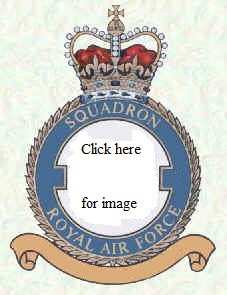Air
of Authority - A History of RAF Organisation
No 291 - 295 Squadron Histories
No 291 Squadron
|
No
Badge Authorised |
This was formed at Hutton Cranswick on 1 December 1943 from No's 1613, 1629 and
1634 Anti-Aircraft Co-operation Flights. It was initially equipped with
Martinets, with Hurricanes being added in March 1944 and Vengeances in November
1944.
It role was to provide target towing and to carry out attack simulations in
order to provide continuation train for anti-aircraft units along the East Coast
and continued in this role until disbanding at Hutton Cranswick on 26 June 1945.
|
Squadron Codes used: -
| MM |
Allocated Apr - Sep 1939 |
[Aircraft & Markings |
Commanding Officers]
No 292 Squadron
|
No
Badge Authorised |
Formed on 1 February
1944 at Jessore in India as a ASR unit, for operations over the Bay of Bengal.
Its initial equipment was the Walrus amphibian but in April some Warwicks were
taken on strength. However, these soon proved unsuited to tropical
conditions and they were replaced by Liberators in December. Sea
Otters also arrived in November and the squadron operated the three types until
disbanding. In February 1945 the squadron moved closely to the operational
area of Burma, re-locating to Agartala, where it disbanded on 14 Jun 1945.
Its dities were taken over by three independent flights, No's 1347, 1348 and
1349. |
Squadron Codes used: -
| UZ |
Allocated Apr - Sep 1939 |
[Aircraft & Markings |
Commanding Officers]
No 292 Squadron
Association: - John Reeves, 46 Ladywell Road, Boroughbridge, N.Yorks. YO51 9HL, tel 01423 323065 fax: 01423 860999, e-mail (via) malreeves@yahoo.com,
Association website
No 293
Squadron
 |
Formed
from a nucleus provided by No's 283 and 284 Squadrons in the UK on 20 October
1943 this unit was destined for ASR operations in the Middle East. At this
point the unit did not have a number, but on 28 November, it was allocated the
number 293.
Based at Blida in Algeria, its Warwicks provided ASR support
along the North African coast and from January 1944 it sent detachments to
operate in Italy. The squadron HQ moved to Italy in March and the
following month it was supplemented by the arrival of Walrus amphibians, taken
over from No 283 Squadron. It continued to operate in the Italian
theatre until disbanding on 5 April 1945. |
Squadron Codes used: -
| XJ |
Allocated Apr - Sep 1939 |
| ZE |
Nov 1943 - Apr 1946 |
[Aircraft & Markings |
Commanding Officers]
No 294 Squadron
 |
Formed
on 24 September 1943 from the ASR flight at Berka, it was equipped with
Wellingtons and Walrus amphibians and provided ASR cover in the Eastern
Mediterranean, with various detachments around the area.
Warwicks were also taken on strength in November 1944 and with these and the
Wellingtons, it also undertook anti-submarine operations. The unit moved
to the Persian Gulf in June 1945, being based at Basra, where it remained until
disbanding on 8 April 1946.
|
Squadron Codes used: -
| AF |
Allocated Apr - Sep 1939 |
[Aircraft & Markings |
Commanding Officers]
No 295 Squadron
 |
With
the build up of airborne forces there arose a need for specialist airborne
forces squadrons to drop paratroops and tow gliders into action. No
295 was one such unit. It was formed on 3 August 1942 at Netheravon and
was equipped with Whitleys. These were supplemented by Halifax Vs in
February 1943 and both types were operated until November 1943 when they were
replaced by Albemarles , which had begun to arrive in October.
Early operations consisted of leaflet dropping missions, but in June
1943 the squadron towed gliders to North Africa and this continued until
September. From October supply drops to resistance forces began and
it started training for its part in the forthcoming invasion of Europe.
On D-Day one squadron aircraft (and one from 570 Squadron) dropped the
first troops into France, followed by the rest of the squadron towing 21
gliders. In July, the squadron converted to Stirling IVs, which were
used in September to tow gliders to Arnhem. The squadron then flew
re-supply missions to the troops there until the operation ended.
Its next major operation was the crossing of the Rhine in March 1945 and
following VE-Day, the squadron flew troops to Norway to disarm German
forces there. Various trooping missions were then carried out until
the squadron disbanded on14 January 1946.
The squadron reformed on 1 February 1946 at Tarrant Rushton in the pure
transport role, equipped with Halifax VIIIs, but on 31 March 1946 it was
disbanded again. Its third incarnation began on 19 September 1947
when it reformed in the airborne forces role, once more, at Fairford, but
this was also short-lived as the squadron disbanded on 1 October 1948.
|
Squadron Codes used: -
| HX
|
Allocated Apr - Sep 1939 |
|
8Z
|
Nov 1943 - Jan 1946 ('A' Flt) |
|
8E |
Feb 1944 - Jan 1946 ('B' Flt) |
[Aircraft & Markings |
Commanding Officers]
Squadron badge image on this page is courtesy of Steve
Clements
© Crown Copyright is reproduced with the permission of the Directorate of
Intellectual Property Rights
This page was last updated on
17/03/25©
 Organisational Index
[Top of
Page]
Sqns 296 - 299
Organisational Index
[Top of
Page]
Sqns 296 - 299

![]() Organisational Index
Organisational Index ![]()